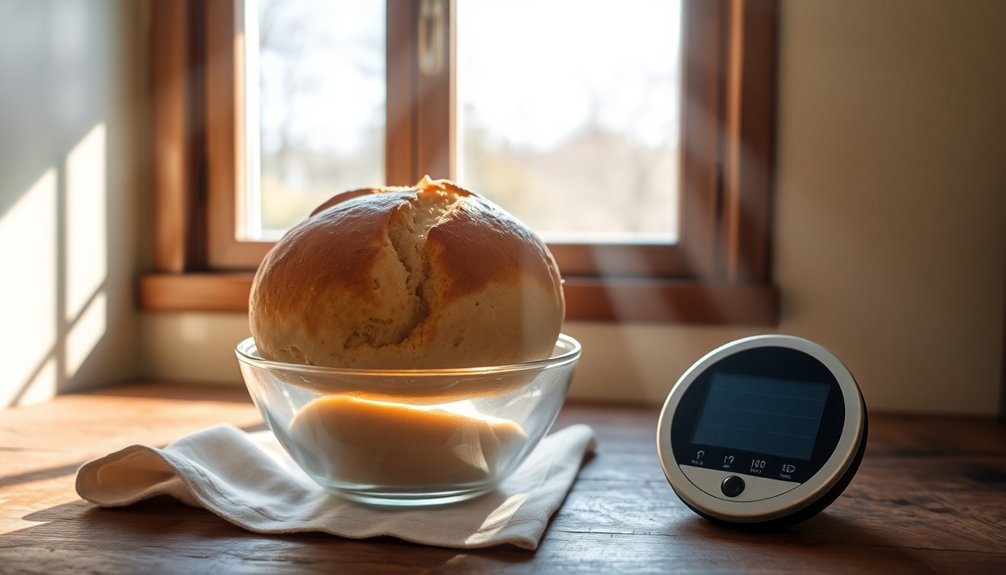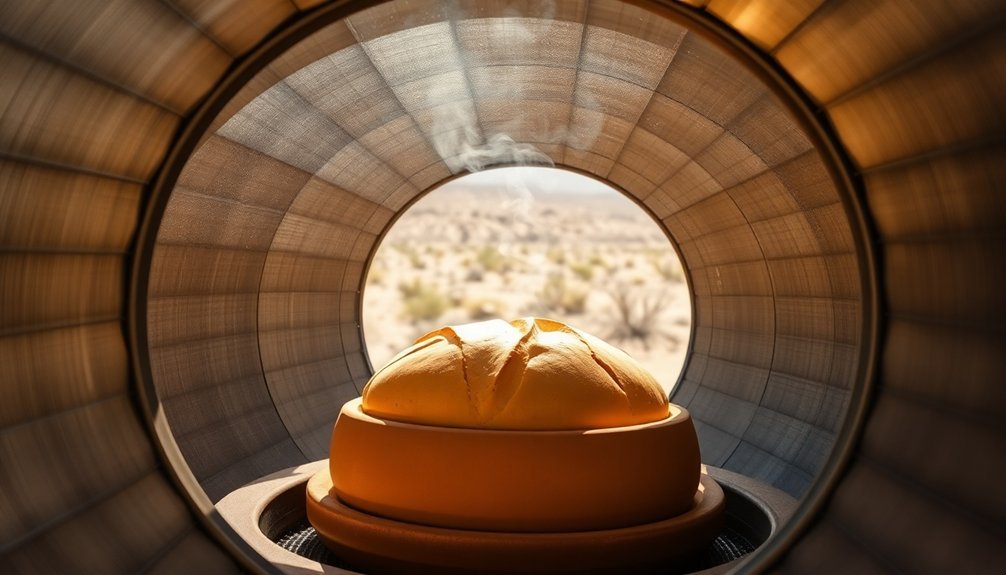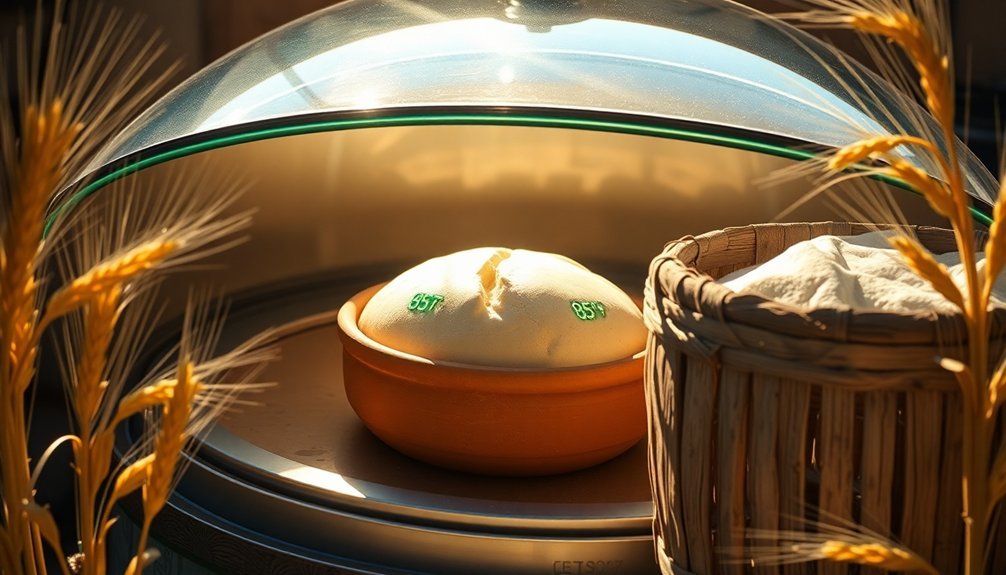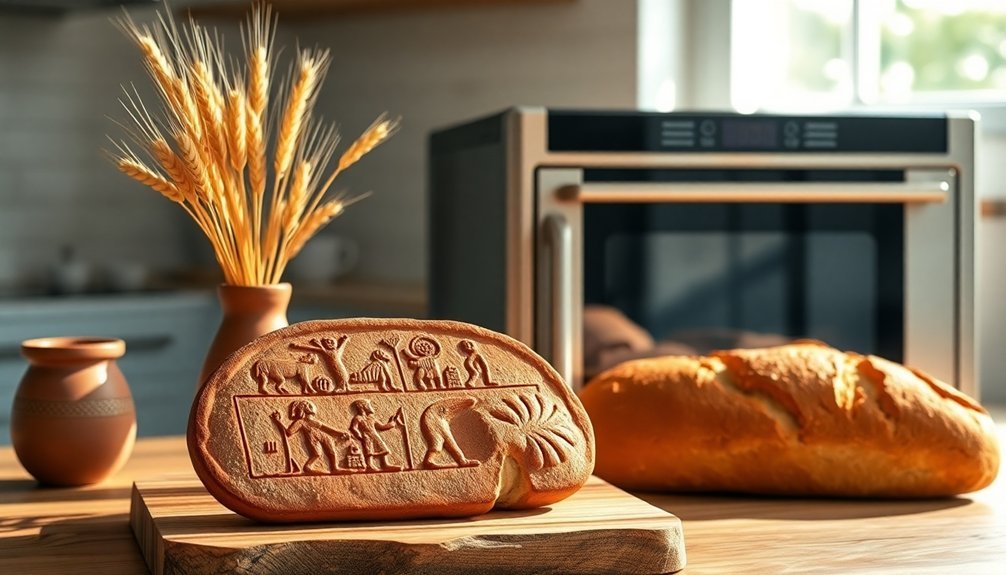You'll find a fascinating blend of ancient wisdom and modern innovation in sun-powered bread making. Since 8,000 BC, civilizations like the Egyptians and Romans mastered the art of natural fermentation using sunlight and careful temperature control. Today's solar-powered proofing boxes combine these time-tested principles with advanced technology, maintaining perfect 80-90°F conditions through perovskite and bifacial innovations. While ancient bakers relied on cloth coverings and strategic placement near heat sources, modern bakers can achieve consistent results using smart monitoring systems and environmentally conscious practices. This journey through time reveals how traditional techniques continue shaping our future.
Dough Rises Under Ancient Sunlight

While ancient civilizations didn't fully understand the science of fermentation, they mastered the art of rising dough through careful observation and inherited wisdom.
You'll find evidence of their expertise dating back to 8,000 BC, when civilizations like the Egyptians and Romans developed sophisticated fermentation methods using natural leavening agents. Traditional bakers continue this practice by using sourdough as yeast for bread-making.
These early bakers recognized that direct sunlight could be both friend and foe to the rising process. They'd protect their dough with cloth coverings and strategically place it in shaded areas to maintain ideal fermentation conditions.
In colder seasons, they'd use copper kettles filled with charcoal to provide warmth. Their techniques were so effective that writers like Pliny the Elder documented these methods in his work "Naturalis Historia" around 77 AD.
Solar Proofing Through The Ages
While early bakers relied on outdoor proofing methods using ambient sunlight, you'll find that modern solar-powered proofing techniques offer more control and efficiency.
You can transform a simple box-style solar cooker into an effective proofing chamber by maintaining lower temperatures around 80-90°F (27-32°C).
Modern solar proofing combines the ancient wisdom of harnessing sunlight with precise temperature control, making it possible to proof dough consistently even in varying weather conditions. This environmentally conscious approach helps bakers achieve quality results while maintaining reduced carbon footprint throughout the bread-making process.
Traditional Dough Rising Methods
Throughout history, ancient civilizations mastered the art of dough rising by harnessing natural warmth and humidity in their environments. From the communal bakeries of ancient Egypt to the bread-making traditions of Greece and Rome, bakers understood that maintaining ideal conditions was essential for perfect bread.
You'll find that traditional methods relied heavily on natural heat sources. Bakers would place their dough near woodstoves, fireplaces, or in warm, enclosed spaces. They'd create humid environments by covering dough with moisture-trapping materials or using steam from nearby cooking. The consistent presence of hot water and steam was crucial for creating the perfect rising environment.
The perfect temperature of 75-78°F wasn't just a modern discovery – ancient bakers instinctively sought spaces that maintained these conditions.
In the Fertile Crescent, where bread-making originated, natural warmth and humidity provided excellent conditions for dough fermentation, leading to the development of time-tested techniques we still use today.
Modern Solar-Powered Proofing Techniques
As solar technology has revolutionized energy production, it's also transformed the ancient art of bread proofing. You'll find innovative solar-powered proofing boxes that harness perovskite technology, achieving consistent temperatures while using minimal energy.
These modern systems integrate smart monitoring features that let you track your dough's progress in real-time. Under optimal conditions, these proofing boxes can reach temperatures of up to 200 degrees Fahrenheit. The flexible nature of today's solar materials means you can install proofing systems almost anywhere.
Bifacial technology captures sunlight from multiple angles, ensuring your proofing chamber maintains steady temperatures even on cloudy days. With energy conversion rates reaching 22%, these systems are considerably more efficient than traditional methods.
You're not just saving energy – you're participating in a broader movement toward sustainable baking practices that align with global environmental goals.
Modern Solar Bread Making

Since the advent of modern solar technology, bread making has evolved to embrace sustainable energy solutions through various innovative oven designs.
You'll find different types of solar ovens, from tubular models that create perfect crusts to parabolic reflectors ideal for longer baking times.
You can now bake various breads using solar power, including soft bread with T55 flour, organic multigrain loaves, and whole wheat varieties.
You'll need to preheat your solar oven – temperatures can reach 180°C in tubular models. Baking times vary from 25 minutes to 2.5 hours, depending on your oven type and recipe.
This modern approach isn't just about baking – it's creating positive change.
Solar bakeries are bringing jobs to remote villages, promoting energy independence, and reducing deforestation by eliminating the need for wood-burning ovens.
Traditional Yeast and Sunlight Methods
Before modern conveniences revolutionized baking, traditional bread makers relied on natural sunlight to activate their yeast and create the ideal environment for dough fermentation. They understood that yeast thrives in temperatures between 70°F and 100°F, making sun-warmed spaces perfect for dough rising.
| Traditional Method | Modern Equivalent |
|---|---|
| Sun-warmed water 105-115°F | Thermometer-measured water |
| Natural window light warmth | Temperature-controlled proofing |
| Seasonal timing adjustments | Year-round consistency |
You'll find these ancient techniques still work today. When proofing your yeast, place your bowl in filtered sunlight to reach the suitable 40-45°C activation temperature. While you won't need to rely solely on the sun like your ancestors did, understanding these traditional methods can help you appreciate how environmental factors affect your bread's rise and flavor development.
Optimizing Temperature for Solar Rising

While mastering solar-powered baking requires attention to detail, optimizing your setup's temperature begins with proper positioning and insulation.
You'll need to face your oven directly toward the sun and adjust it every 30-45 minutes to maintain peak heat collection. For consistent rising temperatures, surround your cooking cavity with multiple layers of insulation like crumpled newspaper or dry leaves.
- Monitor your temperature range (150-225°F) using a digital thermometer with probes.
- Install reflective panels and adjust their angles to concentrate sunlight without casting shadows.
- Protect your setup from wind interference by choosing a sheltered location.
Remember to preheat your solar oven before adding your dough, and use weather data to predict ideal baking conditions.
Clean reflectors and secure glazing will help maintain steady temperatures for proper rising.
Cultural Heritage of Sun Proofing
Throughout history, cultural heritage sites have faced significant challenges from the damaging effects of sunlight exposure. You'll find that ancient civilizations developed innovative methods to protect their cultural treasures, much like today's UV-blocking window films.
| Protection Method | Cultural Application |
|---|---|
| Traditional Shading | Igorot people's architectural techniques |
| Community Systems | Yunnan's water management practices |
| Folk Knowledge | Local stories guiding preservation |
You can learn valuable lessons from these traditional practices while implementing modern solutions. UNESCO's preservation efforts show that combining ancient wisdom with contemporary technology yields the best results. By involving local communities and understanding seasonal light variations, you're better equipped to protect historical materials from UV damage. This balanced approach helps maintain both the physical integrity and cultural authenticity of heritage sites.
Frequently Asked Questions
Can Solar-Proofed Bread Develop Unique Flavors Compared to Conventional Methods?
Yes, you'll find solar proofing can create distinct flavors through consistent temperatures that allow slower, more controlled fermentation. It's like giving yeast an extended vacation to develop deeper, more complex taste profiles.
What Backup Methods Exist When Clouds Interrupt Solar Bread Proofing?
You'll find multiple backup options: use the GoSun Fusion's electric mode, place dough near heating pads, try microwave-warmed water, utilize seed mats, or rely on insulated containers to maintain ideal proofing temperatures.
How Does Humidity Affect Dough Rising in Solar Proofing Boxes?
You'll need proper humidity (60-80%) in your solar proofing box for ideal dough rising. Place a water tray inside to create moisture, as humidity prevents drying, supports yeast activity, and promotes better fermentation.
Which Bread Varieties Are Most Successful With Solar Proofing Techniques?
You'll find that soft bread and French-style loaves work best with solar proofing. Their extended rise times match well with solar box temperatures, and they'll benefit from the consistent warmth and humidity levels.
Does Altitude Impact the Effectiveness of Solar Bread Proofing Methods?
Yes, altitude considerably impacts your solar proofing results. You'll need to reduce proofing times and increase hydration at higher elevations, while carefully monitoring temperature since solar heat combined with altitude accelerates fermentation.
In Summary
You'll find that both ancient and modern solar bread-making techniques share a beautiful simplicity. Whether you're using traditional methods or modern solar ovens, the sun's warmth remains a reliable partner in dough fermentation. By understanding ideal temperatures and timing, you can blend time-tested practices with today's sustainable technology. Keep exploring these eco-friendly baking methods – they're connecting you to centuries of baking wisdom while embracing a greener future.





Leave a Reply